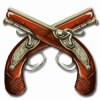In another thread, Salamanca talked about his experiences with running 7th Sea for a large group (8+ players). He said:
Item two: Group Size
I asked him point blank how big a group they playtested with and he told me they tested the game with all sorts of sizes. I then revealed I had just ran three consecutive sessions of 10 players and was feeling a bit overwhelmed creating enough consequences with variety in some places. His eyes went wide, he gulped, stammered a bit and said "Ten? at the same time? We only tested up to five!" So the game is designed for small group play. Nobody ever even thought about it being used for even the standard convention table of six. If you have a larger group, you are going to see some glitches it seems. John's solution for big groups is to go LARP instead of tabletop (which we have no rules for and kind of goes against my plans when I drop the game for freeform play)
Ok Sal, as someone who regularly runs games for around 10 players (usually Savage Worlds and B/X D&D), I really want to know what gliches you ran into? I want to know where the thing bogged down. Upon reflection, are there any tricks or tools that would be handy to remedy the problems you encountered?
I expect to run the game for my regular crew of 7 players (usually 6 as one of them is habitually absent) so this is a matter that I've very interested in hammering out.






That's a really, really interesting point of Salamanca research.
Many of our team issues of the system, 6-7 players, can be related with that point.
And yes, our backup plan it's 7th Sea 1st edition for sure. Maybe with brute squads lvl 3-4...
For the experienced GMs, how do you ensure enough screen time, those famous "15 minutes of Fame" for everyone in a group of 8 or 10 at the table for an average 3 hour game slot?
TAJ-07: Technopriest And Justicar Of 7thSea2e
I just received a brainway communication. "John Wick recommends the potion of quick wits".
And @Salamanca, thanks for meeting in person the deity of Theah at Origins.
TAJ-07: Technopriest And Justicar Of 7thSea2e
For groups of 8+, I recommend nominating a second GM. If the group doesn't mind splitting, you can run two smaller groups simultaneously in slightly different Earth-spaces (even two ends of a living room works). The groups can be in very different places in Theah, allowing some sweeping, nation-changing storylines (if desired). And the rumors you can set up between the groups about who said or did what and when are delightful.
Assuming all 8-10 want to stick together as one large party, a second GM is still useful for dramatic sequences and combats. The two GMs should step aside, discuss the overall goal(s) for the sequence, and then split the party in half. Each GM runs half the group, assigning consequences and opportunities as appropriate and coordinating the action between groups using the same raise count-down as the 'anchor'. In 1st ed, we've seen the secondary GM run a regular character successfully while doing this. There's probably a way to make it work without bogging down the action too much in 2nd ed, but we haven't tried it. If all 10 players were in a combat with a single Villain, this technique probably won't work well.
Coordinating individual storylines and character goals (we were doing that back in 1st ed but not as beautifully formalized as 2nd ed does it) can be challenging. Typically, about half the players would get their "15 minutes" each session--not the same half, obviously, but over the course of 4 sessions, everyone got about 2 opportunities to shine/times when the action focused on them. I recommend the GM keep a player log to track these focal moments to make sure no one is left out. Salamanca made another excellent point: varying the types of challenges will naturally bring different players to the front.
One mechanism we are experimenting with in our group is the use of "player NPCs". Suppose you have a large group whose splitting-up privileges have not been revoked. They will split up. It's inevitable. Let's assume that a large group has split into 2 smaller groups, A and B. The GM can run a session which features A. Before that session starts, the GM assigns key NPC roles to the members of B. During the session, everyone is involved, everyone is having fun, and the GM can focus on coordinating the action. The next session, the members of A have the fun of running some NPCs, and the Bs take the starring roles. As bonuses, this technique yields some rich, colourful NPCs and puts less wear and tear on the GM's brain.
Good luck!